|
|
 subscribe
subscribe
|
 subscribe subscribe
|

|
. . . . . . . . . . . . . . . . . . . . . . . . . . . . . . . . . . . . . . . . . . |
2000 Italia: Basilica di San Pietro (Saint Peter's Basilica) 3 As we approach the church proper we see a signpost displaying the layout of the alters. I can see where things are, but I don't have a feeling for how big everything will be. 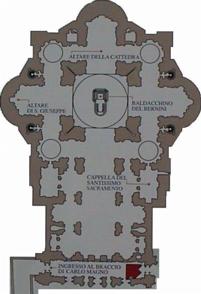 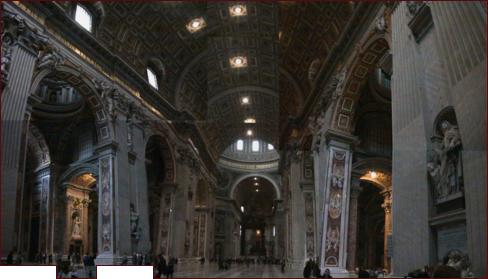 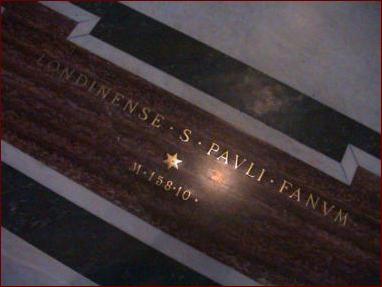 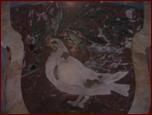
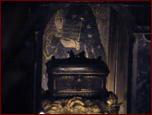
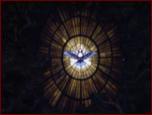
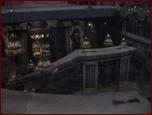
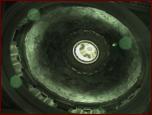
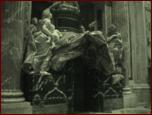
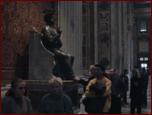
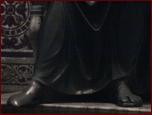 We see a line of Catholic pilgrims heading straight for the last pilaster on the right before the main altar, to kiss the big toe of Arnolfo da Cambio's brass statue of Saint Peter (circa 1296). The toe has been worn down by centuries of pious lips. The statue is a very deep black; we weren't sure whether it was metal or stone.
We see a line of Catholic pilgrims heading straight for the last pilaster on the right before the main altar, to kiss the big toe of Arnolfo da Cambio's brass statue of Saint Peter (circa 1296). The toe has been worn down by centuries of pious lips. The statue is a very deep black; we weren't sure whether it was metal or stone.Heading out of the church, going against the flow of tourists back toward the Puerto Santo, we come up to the Florentine Pietà, completed in 1499 by Michelangelo di Lodovico Buonarroti Simoni (b. 1475, Caprese, d. 1564, Roma) when he was 24 years old. It is his only signed work. There's much to be said about the Pietà, a statue that depicts the Virgin Mary, the Madonna, holding the body of Jesus Christ. The contrast between the nude body of Christ against the copious drapes of the Madonna's clothes is stark. His hand dangling in mid-air and the limp body almost sliding off her lap suggests the quiet finality of death, as does the look of supressed grief on her face. It's said that this work represents pity, done at a time when most works were of the deposition from the cross or the weeping for the dead Christ. 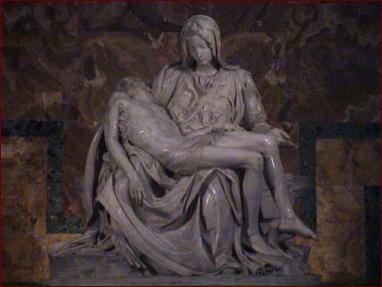 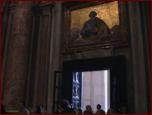
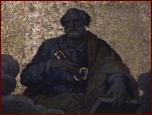 Now we approach the inside of the Puerto Santo. It is believed that walking through the sacred door cleanses one of sins. Above the door is a mosaic of St. Peter holding the key to the Gates of Heaven. Here's a close-up. I think that's the Book of Life held in his left hand. Traffic through the Puerto Santo is one-way; perhaps one gains the sins of others if one walks the other way?
Now we approach the inside of the Puerto Santo. It is believed that walking through the sacred door cleanses one of sins. Above the door is a mosaic of St. Peter holding the key to the Gates of Heaven. Here's a close-up. I think that's the Book of Life held in his left hand. Traffic through the Puerto Santo is one-way; perhaps one gains the sins of others if one walks the other way?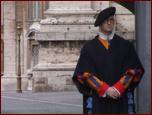
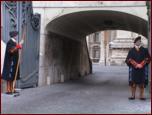 We leave the Basilica di San Pietro by one of the other doors and head out as directed. In a few moments we see the Swiss Guard holding secure one of the entrances to the Santa Sede (Stato della Citta del Vaticano), the Holy See (State of the Vatican City). It's the world's smallest state, including the thirteen buildings in Rome and the Castel Gandolfo (the pope's summer residence) enjoy extraterritorial rights. It has a unique, noncommercial economy; supported financially by contributions from Roman Catholics throughout the world (known as Peter's Pence), the sale of postage stamps and tourist mementos, fees for admission to museums, and the sale of publications.
We leave the Basilica di San Pietro by one of the other doors and head out as directed. In a few moments we see the Swiss Guard holding secure one of the entrances to the Santa Sede (Stato della Citta del Vaticano), the Holy See (State of the Vatican City). It's the world's smallest state, including the thirteen buildings in Rome and the Castel Gandolfo (the pope's summer residence) enjoy extraterritorial rights. It has a unique, noncommercial economy; supported financially by contributions from Roman Catholics throughout the world (known as Peter's Pence), the sale of postage stamps and tourist mementos, fees for admission to museums, and the sale of publications.This isn't the time we'll visit San Pietro during this trip; next time we'll see his holiness, Il Papa.
|
| Have you found errors nontrivial or marginal, factual, analytical and illogical, arithmetical, temporal, or even typographical? Please let me know; drop me email. Thanks! |